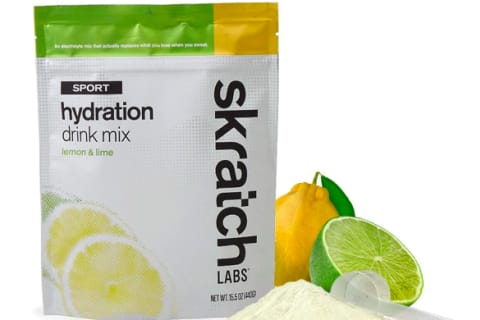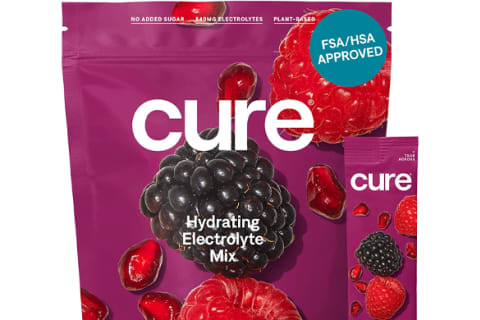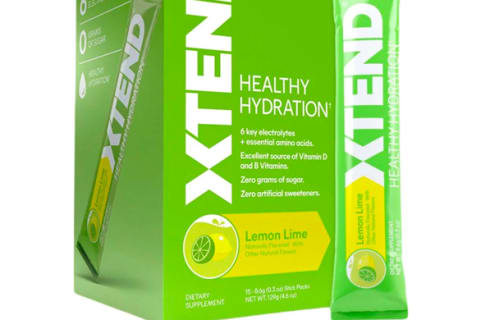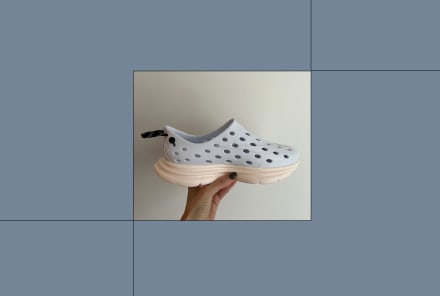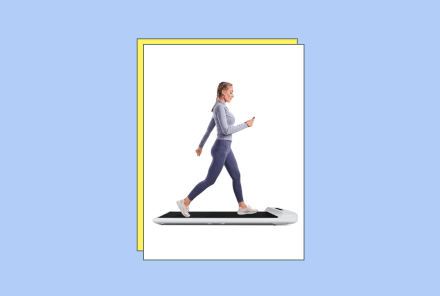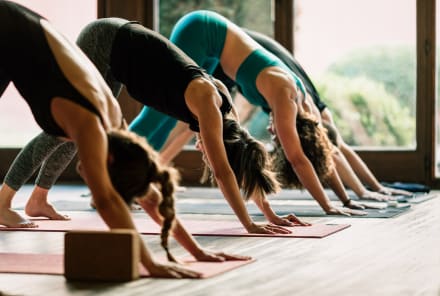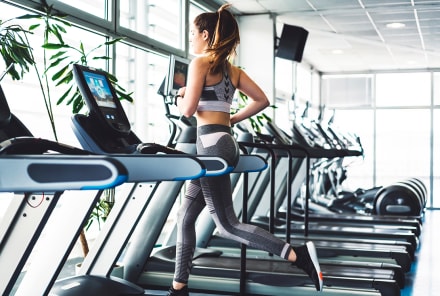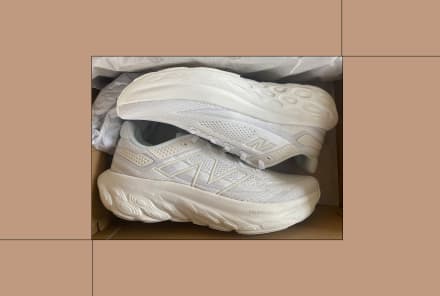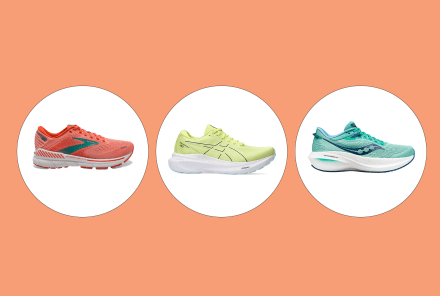Advertisement
Your Definitive Guide To Getting Electrolytes: Types, Timing & More


With all the mineral-infused beverages, foods, and supplements on the market these days, it might seem like everyone should be loading up on electrolytes at all times. But the reality is that only certain groups of people and certain circumstances require electrolyte replacement. Curious about whether you really need that sports drink or powder? We've got experts' answers on how to get electrolytes (and who really needs them).
The need-to-knows:
- Electrolytes are essential: Electrolytes are minerals that carry an electric charge. Our bodies need them for important processes like muscle contraction, but we lose them through fluids like sweat.
- ...But not everyone loses enough of them to warrant replenishment: People who do high-intensity workouts or exercise for more than 60 minutes at a time, people who are sick, and people who spend a lot of time out in hot climates may need to get more electrolytes. Others won't need to worry about it.
- Electrolytes don't just come in the form of sports drinks: Some fruits, vegetables, and snacks are good whole-food sources of electrolytes. Adding them to your diet can help ensure your bases are covered.
What are electrolytes?
You've probably seen them marketed on sports drinks, fruits, and juices, but what are electrolytes? Short answer: They're minerals! As their name suggests, these dietary minerals (which include sodium, potassium, magnesium, and more) carry electric charge1, creating important chemical reactions in the body. These include controlling muscle contraction, maintaining fluid balance, and calibrating the proper acidity of blood.
Electrolytes float around in our bodily fluids, so when we lose fluid through sweat, urine, feces, or vomit, we can end up with too few of them. When this happens, we can experience unpleasant symptoms like fatigue, muscle spasms, nausea, and more—so it's important to replace lost electrolytes with food or supplements as needed.
Summary
Electrolytes include:
- Sodium
- Potassium
- Magnesium
- Chloride
- Phosphorus
- Calcium
Who needs electrolytes after a workout?
There are times when a sweaty workout may leave you depleted enough to need a mineral boost. "Athletes should know that there are several scenarios requiring them to replenish electrolytes," says Jen Scheinman, M.S., RDN. "Since electrolytes are lost during sweat, they should be replenished during workouts that last longer than 60 minutes, high-intensity exercise, or any exercise done in hot and humid conditions."
The only way to accurately determine if your electrolytes are low is a blood test. But since most of us don't have access to medical-grade testing after a workout, some physical signs and symptoms of an electrolyte imbalance are a more realistic measure.
"Symptoms of dehydration during a workout, like fatigue, headaches, muscle cramps, or dizziness can be a sign of electrolyte imbalance," says Scheinman. If you notice these during or after heavy exercise, it's probably time to reach for some electrolyte-rich foods or drinks.
"Electrolyte imbalances can sometimes affect brain function, resulting in mood swings2, irritability, or even mental confusion," dietitian Susan Schachter, MSRDN, previously told mindbodygreen, so look out for these symptoms too.
Summary
Other times your body needs more electrolytes
Some other occasions when you may need extra minerals include:
- Spending time in extreme heat: Gardening in 100 degrees and humidity? Hiking in Arizona in the summer? You'll likely sweat enough to lose a significant percentage of electrolytes.
- Pregnancy: There are no official guidelines for increasing your electrolytes during pregnancy, but if morning sickness leaves you dehydrated, talk to your doctor about whether you need to restock your lost electrolytes.
- Advanced age: People above 65 should be mindful of electrolyte consumption for several reasons, says Scheinman. "They may have trouble with fluid and electrolyte balance, or they may have issues with thirst signals or kidney function, or they may be on medicines that can alter fluid and electrolytes." If you're an older adult, consider supplementing with an electrolyte replacement drink to get ahead of these issues.
- Hyperhidrosis: Some people just naturally sweat more, while some have a medical condition called hyperhidrosis3 that causes excessive sweating. Others have especially salty sweat. "Salty sweat-ers create sweat that leaves a white, grainy film behind on their face or clothes," says Julie Stefanski, RDN, LDN. These chalky stains on your clothes are a sign you're losing minerals.
- During periods of vomiting and/or diarrhea: There's a reason electrolyte drinks are classic companions for stomach flu. Fluid losses from vomiting and diarrhea typically require electrolyte replacement.
- Heart and kidney disease: Because heart and kidney conditions can cause fluid imbalances, Scheinman says people with these conditions need to be especially careful about electrolyte consumption.
How to get electrolytes
So…how do you get electrolytes back in balance when they're low? You've got lots of options. Powders, dietary supplements, drinks, and foods can all replenish you when your stores are low. (We've got specific recommendations below.)
When selecting an electrolyte replacement, read food and supplement labels to know how many milligrams of sodium, potassium, calcium, phosphorus, and chloride you're getting.
Of all the electrolytes lost through bodily fluids, sodium may be the most important to replace. According to 2021 research4, dehydration arises primarily from sodium losses, and the study notes that an extreme athlete (in this case, an Ironman triathlete) could expect to lose over 14,000 milligrams of sodium through sweat in 12 hours.
When you replenish your fluid stores with water alone (and don't include sodium), you could also end up overhydrating, leading to hyponatremia, a dangerously low level of salt in the blood.
Then again, most of us consume too much sodium, not enough—so hitting the sweet (or, more accurately, salty) spot can be tricky. To consume enough sodium without causing damage to your health, Stefanski says timing matters.
"Timing sodium intake with exercise so that sodium is consumed after sweating is one way to replace electrolyte loss without exceeding recommended sodium guidelines for the entire day," she explains. The FDA recommends consuming less than 2,300 milligrams5 of sodium daily, so keep this limit in mind when choosing how to replenish. (Some electrolyte powders contain over 1,000 milligrams of sodium in a single serving!)
Summary
Sources of electrolytes
Electrolytes come in some surprising packages! Here are a few food and drink sources of electrolytes, plus the specific minerals you'll find in them:
Coconut water
If you dig the unique taste of coconut water, go ahead and grab a can for more natural electrolyte replacement. Pure coconut water supplies 600 milligrams of potassium and 252 milligrams of sodium6 per cup, plus smaller amounts of magnesium and phosphorus.
Juice
Many Americans don't get enough potassium7, but juice is an excellent way to load up. A 1-cup glass of OJ, for example, contains 443 milligrams8. Just beware of the high sugar content in some packaged juices.
Salty snacks
Ever wondered how to get electrolytes without sugar? Turn to snacks like salted peanuts, popcorn, or edamame. You'll get plenty of sodium without added sweetener.
Milk
Cow's milk naturally contains the electrolyte trifecta of calcium, phosphorus, and potassium. If you're not a fan of straight milk drinking, pour some into a smoothie or bowl of cereal.
Dried apricots
For an easy, electrolyte-rich workout snack, stock your gym bag with dried apricots. They're some of the highest-potassium foods around at 1,510 milligrams per cup9. They're also a natural source of calcium and magnesium.
Sports drinks
Of course, you can reach for electrolyte drinks or powders for a quick hit of sodium, calcium, and other electrolytes. Here are the 10 best options of the year for keeping your body hydrated.
Salt
Can you guess which electrolyte salt contains? Sodium, of course! Add salt to your veggies, stews, or meats to increase the sodium content (and flavor).
Is fancy salt a better source of electrolytes?
DIY electrolyte drink
Whipping up a DIY electrolyte drink lets you control the flavor and additives in your beverage. Try this homemade mineral replenisher:
Ingredients:
- 1 cup fresh-squeezed orange juice
- 2 cups coconut water
- 1½ teaspoons honey
- ⅛ teaspoon sea salt
Directions:
Blend all ingredients well. Refrigerate leftovers.
Other perspectives on electrolytes
Contrary to popular belief, you don't need to carry a bottle of Something-Ade with you on every trip to the gym. We really only need to get more electrolytes when we've lost significant amounts.
This likely won't happen from activities like a 30-minute jog or easy hike, as these activities don't usually cause excessive sweating. In fact, according to research, most people do not need to consume sports drinks to replenish fluids and electrolytes lost during moderate physical exercise.
Take this 2023 systematic review10 in Nutrients, which analyzed the findings of 15 research articles on the relationship between sports drinks and healthy behaviors. From this in-depth investigation, researchers concluded that it was more useful for non-athletes to focus on water consumption, rather than consumption of electrolyte beverages, for rehydration. During moderate physical exertion, most healthy people did not need sports drinks to replenish lost electrolytes.
Side effects of too many electrolytes
When it comes to electrolytes, more isn't always better. It is possible to overdo it on minerals like sodium and potassium. This could potentially be dangerous.
"Very high doses of any electrolyte can cause harm and even death, as it can interfere with a person's heart rhythm and blood pressure regulation," says Stefanski. She points out, for example, that the recommended potassium intake for healthy individuals is 2,600 milligrams for females and 3,400 milligrams for males. For most people, there's no need to go above these numbers.
Similarly, the recommended daily limit for sodium is 2,300 milligrams. Regularly going past this could set you up for health problems like heart disease, kidney disease, or high blood pressure.
Don't forget, too, that many electrolyte drinks contain super-high amounts of sweetener. Be sure to check nutrition labels and stick to recommended portion sizes so you don't overload your system with sugar.
The mindbodygreen POV
Most people don't lose electrolytes fast enough to need to worry about replenishing them. However, people who live in hot climates, have certain medical conditions like heart and kidney disease, or work out for over 60 minutes at a time will want to think about adding electrolyte-rich foods or drinks into their routine.
For those folks, getting enough electrolytes has never been easier: There are now plenty of sports drinks and electrolyte powders on the market, and certain foods and drinks are high in key electrolytes too. Refuel by keeping your favorites on hand after a workout—just be sure to check the sugar content first. Eating a variety of whole foods daily will also help ensure you get the minerals you need (30-plant challenge, anyone?).
As a distance runner, I'm prone to feeling lightheaded and nauseous after longer runs over 1.5 hours. Drinking a glass of water with a Nuun tablet (and replenishing my body with protein and carbs) is usually enough to bring me right back to life. Shop some of our other editor-favorite electrolyte powders below:
—Emma Loewe, mindbodygreen Health & Sustainability Director
Shop electrolyte powders
FAQ
How do you obtain electrolytes naturally?
Common foods and drinks contain more electrolytes than you might realize. Barring any health reason or major athletic endeavor, most people can get enough of them through a healthy diet. Focus on mineral-rich foods like the ones listed above for sufficient electrolyte levels.
What is the best source of electrolytes?
Specially formulated sports beverages, bars, and powders tend to contain optimum levels of multiple electrolytes—so these products may be your best bet after a heavy sweat. Still, plenty of other foods and drinks are excellent sources of electrolytes too. If you'd rather not shell out the cash for a sports drink, consider replenishing your stores with milk, coconut water, or orange juice.
What are the signs of low electrolytes?
If you're low on electrolytes, it's easy to confuse your symptoms with other issues. "The feeling of being low in an electrolyte like sodium or potassium can mimic many other conditions," says Stefanski. But there are some hallmarks to watch out for. Feeling faint or lightheaded, having muscle cramps, or experiencing weakness can indicate low electrolyte levels, she says. If these symptoms persist after replenishing your electrolytes, reach out to a doctor.
The takeaway
Just because you went for a run or spent time in the sun doesn't necessarily mean you'll need to replace lost electrolytes. Only certain scenarios really require electrolyte replacement. Think lengthy exercise that leaves you sweating heavily, a bout of stomach illness, or chronic dehydration from a health condition. When you do need electrolytes, focus on getting sodium first and foremost—whether it be through foods, drinks, or electrolyte powders. Still wondering about how to balance your hydration efforts? Don't miss our guide to healthy rehydration.
13 Sources
- https://www.ncbi.nlm.nih.gov/books/NBK218740/
- https://www.ncbi.nlm.nih.gov/pmc/articles/PMC6769552/
- https://www.ncbi.nlm.nih.gov/books/NBK459227/
- https://www.ncbi.nlm.nih.gov/pmc/articles/PMC8001428/
- https://www.fda.gov/food/nutrition-education-resources-materials/sodium-your-diet
- https://fdc.nal.usda.gov/fdc-app.html#/food-details/170174/nutrients
- https://ods.od.nih.gov/factsheets/Potassium-Consumer/
- https://fdc.nal.usda.gov/fdc-app.html#/food-details/169100/nutrients
- https://fdc.nal.usda.gov/fdc-app.html#/food-details/173941/nutrients
- https://www.ncbi.nlm.nih.gov/pmc/articles/PMC10346316/
- https://pubmed.ncbi.nlm.nih.gov/32830237
- https://pubmed.ncbi.nlm.nih.gov/36789935/
- https://pubmed.ncbi.nlm.nih.gov/26376619/
Watch Next
Enjoy some of our favorite clips from classes
Enjoy some of our favorite clips from classes
What Is Meditation?
Mindfulness/Spirituality | Light Watkins
Box Breathing
Mindfulness/Spirituality | Gwen Dittmar
What Breathwork Can Address
Mindfulness/Spirituality | Gwen Dittmar
The 8 Limbs of Yoga - What is Asana?
Yoga | Caley Alyssa
Two Standing Postures to Open Up Tight Hips
Yoga | Caley Alyssa
How Plants Can Optimize Athletic Performance
Nutrition | Rich Roll
What to Eat Before a Workout
Nutrition | Rich Roll
How Ayurveda Helps Us Navigate Modern Life
Nutrition | Sahara Rose
Messages About Love & Relationships
Love & Relationships | Esther Perel
Love Languages
Love & Relationships | Esther Perel
